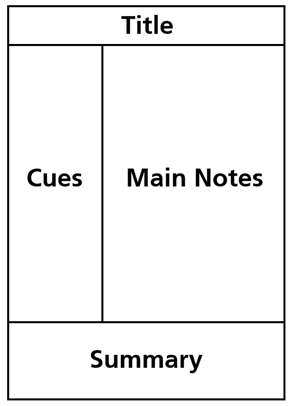Want to learn how to take better notes for class? 🎓

It all comes down to the method you choose!
One of my favorite learning strategies is the Cornell note-taking method. It has helped me stay organized, manage my time, and study more effectively during college.
Here's how you can implement it today.
Prepare Your Layout 🛠️
Before your lecture, spend a few minutes creating the basic layout of your Cornell notes. This way, you can focus on the note-taking once your class has started, rather than obsessing over how symmetric your lines are!
Take a look at this layout template for the Cornell note-taking method:

Ready to create Cornell notes? Follow these steps:
Create space for the title by drawing a horizontal line across the page about 1 inch from the top.
Next, draw a vertical line down from the horizontal one about 2.5 inches from the left side of the page, stopping 2 inches before the bottom. On the left are the Cues,and on the right are your Main Notes.
Finally, draw a horizontal line across the page 2 inches from the bottom for the summary.
Now let's get into each of the Cornell note-taking method's sections!
Title 🗂️
Have you ever found yourself searching for a specific ingredient, only to find that your kitchen pantry is filled with unlabeled jars that all look the same? Frustrating, right?

In the same way, flipping through your notes without a clear title can make it difficult to find the information you need. That's why it's so important to title your notes properly!
In your Title section, consider including:
Name of the lecture or chapter
Date
Professor's name or course number
You can also use this space to create a small key of symbols or abbreviations that you eventually use in your main notes section, helping you remember what each character stands for.
Here's an example:

To hear an audio version of the information in the image above, click the play button on the audio player below:
Now, it's time to start using the Cornell note-taking method in class!
Main Notes 📝

You've prepared your Cornell note-taking method template and Title section, and made it to class. Great! Now, you'll fill in the Main Notes column.
Here, you'll capture only the most important information and leave out anything that isn't necessary to your understanding. Keep your sentences short and concise.
Write down:
Key information: Focus on important ideas and examples the instructor writes on the board or stresses in class
Definitions: Write down the meanings of key terms
Abbreviations: Shorten words to write faster, such as "b/c" for "because"
Symbols: Use characters or signs like "&" and "="
Diagrams: Create simple illustrations, such as mind maps and Venn diagrams
Here's an example:
If you're in a lecture about strokes, your Main Notes section might look like this:

To hear an audio version of the information in the image above, click the play button on the audio player below:
Now You Try It! 🙌
Imagine this. You're watching an educational video about Japanese food and you hear:
"Wagashi is a delightful traditional Japanese sweet made with mochi, anko, agar jelly, and more. People often enjoy them with a cup of green tea."

What's the best way to write this down using the Cornell note-taking method?
A. Japanese sweets, mochi, anko, agar jelly, sweet. Green tea.
B. Wagashi is a delightful traditional Japanese sweet made with mochi, anko, agar jelly, and more. People often enjoy them with a cup of green tea.
C. Traditional Japanese sweet. Ingredients: mochi, anko, agar jelly, & more. Eaten with green tea.
Quiz
What's the best way to write this down?
Cues 🔗

With the Cornell note-taking method, you typically write in the Cues column after you've written your main notes. You can do this either after the lecture or after you write each main point. Do what works for you and your study material!
In this section, you'll write keywords or questions that connect to your main notes to help with studying and quizzing later on. Think of it as questions on the left and answers on the right.
Here's a complete example:
Let's go back to the example of taking notes for a lecture on strokes. Your Cues might look like this:

To hear an audio version of the information in the image above, click the play button on the audio player below:
Summary 📦
Class is over, but there's one last thing you'll need to do to complete the Cornell note-taking method: summarize your notes.

Write a brief overview of the most important information from your notes in 1-4 sentences. Be sure to describe the ideas in your own words and leave out any specific details.
Summarizing your notes will help you actively recall and better understand the learning material.
Here's an example:

To hear an audio version of the information in the image above, click the play button on the audio player below:
Take Action

Give the Cornell note-taking method a try and see if it works for you!
Your feedback matters to us.
This Byte helped me better understand the topic.
